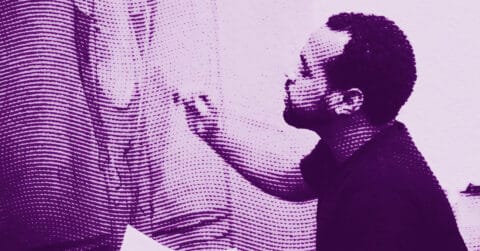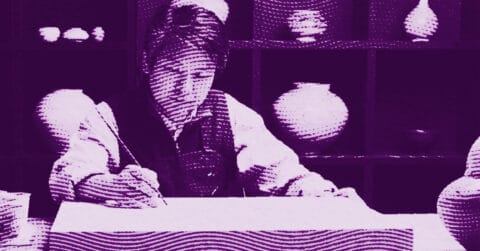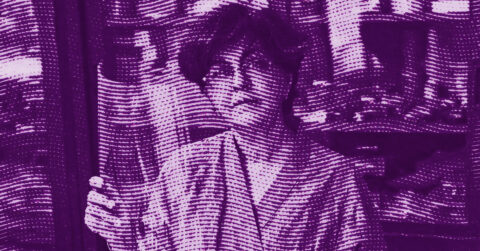Listen to me carefully, you bunch of snobs, Chantal Joffe (born in 1969) is not your salon artist who paints pretty portraits to decorate your sterile interiors. This American who became British, living in London, creates works that will slap you with the force of a truth you would rather ignore. Her monumental canvases, some reaching 3 meters high, are like funhouse mirrors of our society, reflecting a reality that most of us are too cowardly to face.
The first thing to understand: Joffe is not here to satisfy your appetite for “pleasant” art. She paints women, yes, but not like those polished portraits that adorn your fashion magazines. Her brushstrokes are brutal, uncompromising, as if she were tearing the flesh itself from her subjects to expose their souls. It’s like Lucian Freud merged with Alice Neel, but more radical, more visceral. Her portraits of women are acts of resistance against what John Berger called the “male gaze,” you know, that way art history has always represented women as objects of male desire.
When Joffe paints a woman, whether it’s her mother Daryll, her daughter Esme, or herself, she pulverizes conventions with the precision of a sniper. Her female figures do not pose; they exist. They do not seek to please; they assert their presence. It’s as if Simone de Beauvoir had traded her pen for a brush: each painting is a declaration of independence, a manifesto proclaiming “one is not born, but rather becomes, a woman.”
Take her portraits of mother and daughter. That is where Joffe becomes really interesting, my dear snobbish friends. She painted her mother for over thirty years, creating a visual chronicle of aging that makes your Instagram selfies look as deep as a puddle. These portraits are like chapters from a Virginia Woolf novel: every brushstroke tells the story of an ever-changing relationship, marked by the inexorable passage of time.
And let’s talk about her self-portraits! In 2018, she painted herself every day for a year. Not those narcissistic selfies you post on social media with fifteen different filters. No, these works are like brutal confessions, diaries exposed for all to see. It’s like Robert Lowell in painting form, confessional poetry translated into oil on canvas. Each canvas is a journey into the depths of the psyche, an uncompromising exploration of what it means to be a female artist in a world that still prefers its creators tame and docile.
All those self-portraits from 2018 form a particularly powerful corpus. Looking at oneself mercilessly for a year, documenting every mood, every change, that’s great art. It’s as if Roland Barthes had decided to make his “Camera Lucida” in painting, but more visceral, more urgent.
The way she treats flesh is revolutionary. She does not seek to flatter; she seeks to reveal. Her bodies are territories of truth, not manufactured fantasies. When she paints a teenager in a mini skirt, it is not to satisfy the male gaze; it is to capture that precise period of life when one oscillates between vulnerability and defiance. It’s Julia Kristeva meeting Jenny Saville in a pictorial boxing match.
Her technique? As brutal as it is effective. She paints with an urgency that makes your favorite artists look as dynamic as a still life. Her brushstrokes are like knife strikes, each line a decision, a statement. She uses paint the way Sylvia Plath used words: to dissect reality down to the bone.
Her large canvases confront you with an intensity that makes your favorite video installations sound like lullabies. When you stand before a 3-meter-tall Joffe, you cannot escape. She forces you to look, to really see. It’s like being trapped in a conversation with someone who refuses to pretend, who insists on telling the truth, the whole truth.
And don’t get me started on her way of handling color. She uses pinks and blues as weapons, turning tones that could be soft into something almost violent. It’s Rothko deciding to paint people, while keeping all the emotional intensity of his color fields.
Her work on teenage girls is particularly revealing. She captures this pivotal period with an acuity that is teeth-aching. These girls are not the ethereal creatures art history has accustomed us to seeing. They are real, awkward, powerful in their very vulnerability. It’s as if Louise Bourgeois had decided to do figurative painting.
What is fascinating about her work is her way of handling time. She does not paint moments; she paints durations, evolving relationships, identities in constant flux. It’s Henri Bergson brought to life on the canvas, pure duration translated into pigments and oil. Each portrait is like a geological layer, revealing the strata of passing time.
Critics who compare her to Lucian Freud only see part of the story. Yes, there is the same obsessive attention to the detail of flesh, but Joffe goes further. She does not just paint what she sees, she paints what she knows. It’s as if she combines Merleau-Ponty’s phenomenological approach with the emotional brutality of a Frida Kahlo.
Her use of photography as a source is also fascinating. She does not copy photos, she dissects and reinterprets them. It’s Walter Benjamin meeting Francis Bacon: mechanical reproduction transformed into something deeply, viscerally human.
And do not even think for a second that her family portraits are mere exercises in nostalgia. Each painting of her mother, her daughter, is an exploration of power dynamics, the bonds that unite us and sometimes suffocate us. It’s Michel Foucault engaging in figurative painting.
The way she handles space is totally unprecedented. Her figures often seem to float in a void that is not really empty, a space charged with emotion and tension. It’s Gaston Bachelard coming to life on canvas, intimate space becoming an emotional battlefield.
Chantal Joffe constantly navigates between the personal and the political. Each portrait is a statement, each brushstroke is an act of resistance against established norms. She does what Judith Butler theorizes: she performs gender through painting, but in a way that deconstructs rather than reinforces stereotypes.
Chantal Joffe is the artist we need right now. In a world obsessed with appearances, she forces us to look beyond the surface. She paints the truth, even when that truth is uncomfortable. And if it makes you uneasy, so much the better. Art is not here to lull you into your comfort zone.
















